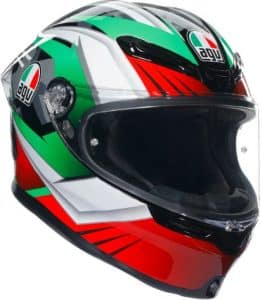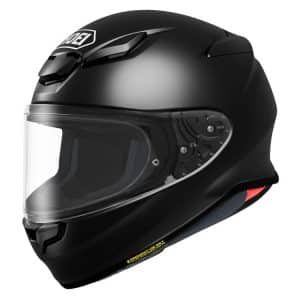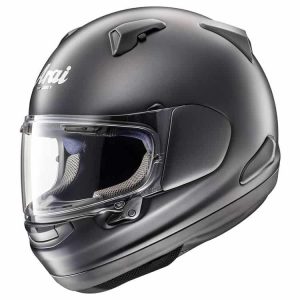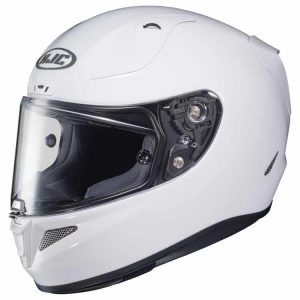For motorcycle lovers, one of the most exhilarating feelings is flying down a road in the open air with the amazing feeling of the wind running across your body as you ride. Unfortunately, though, that sensational feeling of flying like the wind can be significantly diminished if the helmet that you’re wearing makes you feel like you’re inside a deafening wind tunnel which is why many riders search for the quietest motorcycle helmets available:
| Helmet Model | Category | Noise Reduction Percentage | Check & Shop Now |
|---|---|---|---|
| AGV K6 | Lightest Road | Up to 86% | RevZilla | MotoSport | Amazon |
| Shoei RF-1400 | Best All-Round | Up to 85% | RevZilla | MotoSport | Amazon |
| Schuberth C5 | Best Touring | Up to 92% | RevZilla | CycleGear | J&P Cycles |
| Arai Signet-X | Best Track Day | Up to 88% | RevZilla | MotoSport | Amazon |
| HJC-RPHA-11 Pro | Best Value for Money | Up to 82% | RevZilla | MotoSport | Amazon |
| Shark Evo One 2 | Best Sport-Touring | Up to 87% | RevZilla | MotoSport | Amazon |
| Sena Momentum INC Pro | Best Bluetooth & Camera Integrated | Up to 91% | RevZilla | J&P Cycles | Amazon |
| Bell Race Star Flex DLX | Best Road Racing | Up to 89% | RevZilla | MotoSport | Amazon |
| LS2 Challenger | Best Urban Commuter | Up to 84% | RevZilla | MotoSport | Amazon |
Helmets are a critical piece of safety gear as they can protect you from serious head and brain injury in the event of an accident, but if a helmet doesn’t fit properly or allows air to move through the helmet creating a high noise level inside the helmet, this can not only be uncomfortable but also distracting, which can also be a safety concern.
To improve your riding enjoyment and safety you need a helmet that will fit well and reduce noise while you’re riding.
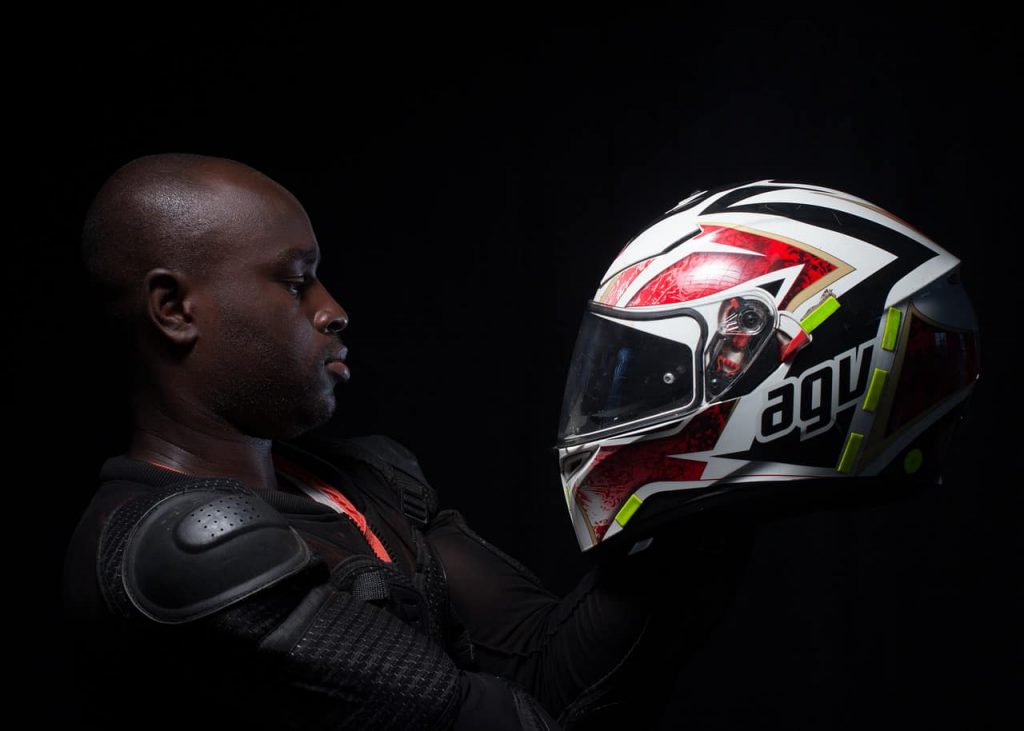
The US Federal Highway Administration has reported that traffic noise on highways can reach 70 to 80 decibels. And the noise generated by a motorcycle engine alone can reach ninety-five decibels and yet other sources indicate the noise level while riding a motorcycle can reach decibel levels of up to 115 in some circumstances.
According to the CDC (Centers for Disease Control and Prevention), exposure to decibel levels of 95 decibels and higher for longer than 50 minutes is enough to risk permanent hearing damage. When considering the amount of time we’re exposed to this noise level on long weekend rides, it’s possible that we could be subjecting ourselves to irreversible hearing damage.
As serious as this concern is, traditionally there is a minimal amount of promotional advertising for helmets that includes a focus on noise level or information about how noisy or quiet a helmet is. And much of what determines the noise level you can experience while riding is dependent upon how well a helmet fits your head despite the roaring traffic and wind around you.
Of course, it’s just not possible to try on every motorcycle helmet that’s currently available on the market, but there are steps you can take to find out which helmets will fit you best. But a properly fitting helmet will offer you the greatest amount of comfort and noise reduction.
What Features Affect Noise Levels in Helmets?

Although there hasn’t been a great deal of marketing emphasis placed on noise level and noise cancellation abilities of helmets in the past (with focus placed more on safety, helmet weight, and aerodynamics), it is evident that this is a growing area of consumer interest and, more recently manufacturers are investing a lot of time and effort in creating designs specifically intended not only to improve aerodynamics but also to reduce noise levels to produce the quietest motorcycle helmets available..
Based on a study performed by the University of Bath in England in 2011, sources of helmet noise are primarily associated with how the air flows through the opening at the neck of the helmet more than across the helmet’s surface.
They also recognized that noise levels vary with how a helmet fits a rider’s head, finding that any opening or ill-fitting component can result in a higher level of wind noise.
If you’ve ever had to deal with a whistling noise in your helmet or from your visor, you’ll relate to this reference. This type of noise caused by airflow inside the helmet could also be associated with poorly functioning features such as neck rolls, chin curtains, cheek pads, and the interior design of a helmet.
Other reports state that primarily a helmet’s aerodynamics plays the primary role in reducing noise levels as when there is less wind resistance, and the wind moves over the surface of a helmet more smoothly, there is less turbulence, which can cause noise. Any feature that disrupts the flow of air over and around a helmet will result in some level of noise inside the helmet. All the quietest motorcycle helmets have good aerodynamics with a tight-fitting face shield.
All these features and components can affect the level of wind and road noise you experience.
Finding a Helmet that Fits Best: Head / Helmet Shape & Size
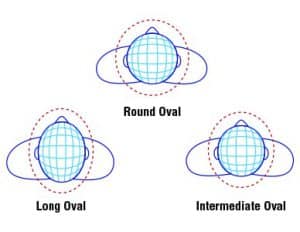
The first step in finding one of the quietest motorcycle helmets is to determine the general shape of your head. There are three primary head shape categories that people’s heads generally fall within.
These categories are round oval, intermediate oval, and long oval. Using a flexible measuring tape, you can take 2 measurements of your head to determine which of the three primary head/helmet shapes apply to you. (If you don’t have a flexible measuring tape, you can use a string or a shoelace and mark these lengths and then measure them with a ruler or non-flexible measuring tape.)
Measure your head from the center of your forehead to the center of the back of your head (front to back dimension). Then, measure your head again from the center of one ear to the center of the other ear (side-to-side dimension). Once you have these dimensions, use the following descriptions to determine which head/helmet shape applies:
- Round Oval: A head that is very round and has almost identical front-to-back and side-to-side measurements
- Intermediate Oval: A head that has a slightly longer front-to-back dimension than the side-to-side dimension. This is the most common category.
- Long Oval: A head that has a noticeably longer front-to-back dimension than its side-to-side dimension.
Once you’ve determined your head shape, the next step is to determine your helmet size.
Helmet sizes (S, M, L, XL, etc.) vary with manufacturers and helmet models so it’s important to determine the actual circumference of your head in order to find the correct helmet size. And, as some helmet sizes are presented using metric measurements in size charts you should the circumference dimension in both inches and centimeters.
You can then use this information to more easily determine which size of each model you look at is the correct size for your head. If the circumference of your head falls between size ranges for any specific manufacturer or model type, select the larger of the two sizes.
To measure the circumference of your head, place the measuring tape just above your eyebrows on the front of your head and then around the back of your head. It’s recommended that you take this measurement multiple times and then select the largest of the resulting dimensions to use when shopping for a helmet.
Now that you know what head/helmet shape you need and which size based on your head’s circumference, you can search for helmet styles that you like that are available in the size that’s right for you.
Trying Motorcycle Helmets On

Through the years engineers have worked to improve the protection offered by helmets and to reduce wind noise caused by wind moving through the helmet. This has resulted in the openings on helmets becoming smaller. When trying on helmets, pull the chin straps apart and pull the helmet on over the largest part of your headfirst (which is usually the back of your head).
When a helmet is new, it should feel very snug and slightly tight with the inner lining contacting most of your head. There shouldn’t be any places where you feel a lot of pressure or pain, but the helmet should not move around freely on your head.
If your helmet is too big and can move up and down or around on your head, it might be noisy and allow more wind in than you would like. You should also keep in mind that in time, the inner lining will begin to compress and conform to the shape of your head, which will cause the helmet to loosen up a little. Some additional checks you can perform to ensure the helmet fits well are:
- You should not be able to insert your fingers in between the lining of the helmet and your forehead.
- The cheek pads should be touching your cheeks.
- On a full-face helmet, the face shield should not touch your nose or chin when you press on the chin piece.
- When the straps are fastened, move the helmet from side to side and up and down. Your skin should move with the helmet, and you should feel a slight, even pressure all over your head.
As mentioned above, your helmet will loosen up some with wear so when purchasing a new helmet, it should fit as tightly as you can comfortably wear it.
Other Noise-Reducing Features
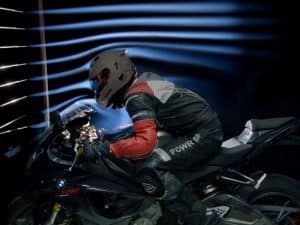
- Helmets that have plenty of padding around the neck can offer some level of noise reduction. And, if the helmet you prefer does not have neck padding, you can also purchase a thick and fitted neck roll or wedge to help reduce the amount of air that flows into the helmet. The better the lining and padding fit to your neck and head, the better the noise reduction. The quietest motorcycle helmets usually have quality comfort.
- A superior quality full-face shield can help significantly with noise control and reduction, too. The face shield should seal properly when closed and should be made of a material that’s sufficiently thick and sturdy (not flexible or easily distorted). Any air ducts or vents on the helmet should also close and seal properly, as any opening or component of the helmet that doesn’t close or fit well can cause additional noise.
- You can also try to shift your riding position while on your motorcycle to see if you’re able to reduce noise as some of the noise may be caused by vibrations running through you and through your helmet.
Top 10 Quietest Motorcycle Helmets Today
| Helmet Model | Category | Noise Reduction Technology | Noise Reduction Percentage | Shell Sizes |
|---|---|---|---|---|
| AGV K6 | Lightest Road | Extensive Turbulence and Aerodynamic Test | Up to 86% | 4: XS-SM, MS, ML-LG, XL-2XL |
| Shoei RF-1400 | Best All-Round | Advanced Noise Reduction System | Up to 85% | 4: XS-S, M, L, XL-XXL |
| Schuberth C5 | Best Touring | Acoustic Aerodynamics Technology | Up to 92% | 2: XS-LG, XL-3XL |
| Arai Signet-X | Best Track Day | Wind-Tunnel Tested Noise Control | Up to 88% | 5: XS, S, M/L, XL, 2XL/3XL |
| HJC-RPHA-11 Pro | Best Value for Money | Advanced Noise Isolation Padding | Up to 82% | 3: XS-S, M-L and XL-2XL |
| Shark Evo One 2 | Best Sport-Touring | Dual Noise Reduction Technology | Up to 87% | 2: XS-MD, LG-XL |
| Sena Momentum INC Pro | Best Bluetooth & Camera Integrated | Sena Noise Control Technology | Up to 91% | 2: XS-LG, XL-2XL |
| Bell Race Star Flex DLX | Best Road Racing | Bell Race-Tested Sound Management | Up to 89% | 6: XS, SM, MD, LG, XL, 2XL |
| LS2 Challenger | Best Urban Commuter | Dynamic Noise Reduction System | Up to 84% | 3: 2XS-XS-S, M-L, XL-2XL-3XL |
After addressing all the above to try to eliminate noise that can be due to poorly fitted equipment, you can also search for consumer reviews of helmets associated with noise levels and noise-canceling qualities. Some of the quietest helmets, based on my own experience, are:
1. AGV K6
If you’re in the market for a quiet sports touring helmet that strikes an impressive balance between performance and comfort, the AGV K6 might just be your perfect match. I was genuinely impressed with its top-notch features, designed with both the touring enthusiast and sportbike rider in mind.
What caught my attention first was AGV’s dedication to safety. The K6 boasts a carbon fiber and aramid shell, coupled with a 5-density EPS liner, earning it a stellar 5-star SHARP rating. Knowing that my safety is uncompromised adds a layer of confidence every rider deserves.
Comfort matters, especially on those long rides, and AGV didn’t disappoint. The interior is meticulously crafted, featuring sculpted foam and advanced fabrics. It’s snug, and even though I wear glasses, I found the fit accommodating. The helmet’s ventilation system is robust, though adjusting vents on the move can pose a challenge initially, but with a bit of familiarity, it becomes remarkably intuitive.
Visually, it’s sleek and purposeful, steering away from flashy designs while still maintaining a modern edge. The visor provides excellent visibility, and the inclusion of a Pinlock anti-fog insert is a thoughtful touch, ensuring clear vision in various weather conditions.
One thing to note is the varying noise levels reported by users. Personally, I found it comfortable, but it’s always wise to wear earplugs for added tranquility on the road.
Benefits:
- Lightweight design
- Advanced shock absorption
- Clear vision
- Comfort redefined
Drawbacks:
- Curved shell pose a challenge when mounting communication systems.
- Slight pressure points on the upper front center of the head.
2. Shoei RF-1400
I’ve been a huge fan of the Shoei RF-1200 since its introduction in 2014 (almost a decade ago, a testament to its enduring excellence). Unfortunately, it has now been discontinued and replaced by the Shoei RF-1400, the quietest helmet for wind noise available now, thanks to improved performance that reduces friction with the air and unwanted lift by 4% and 6% respectively. Notwithstanding the slightly taller profile compared to the RF-1200.
But while buying the RF-1400, I would still manage my expectations because the quietest helmets, at least in my experience, only muffle the sound rather than completely mute it. What I like about the Shoei design is how you can switch between hearing everything to near complete sound isolation by simply flicking the visor open and shut.
Speaking of the visor, the new model borrows the CWR-F2 shield system from the X-15, complete with vortex generators to break up the winds a little bit and reduce buffeting noise. Also worth mentioning is that RFs are optimized for upright riding, i.e., a little extra wind buzz is to be expected when leaning back on a cruiser or tucked in for the roll on a sports bike. Not so loud that you would need your earplugs or anything, but still notably higher sound transmission to the inner cabin.
In terms of coziness, the RF gets full points as it is very comfortable to wear, especially after the helmet break-in period, which I found to be around two weeks of one hour and half daily commutes (approximately 20 hours). But I did experience a bit of discomfort putting it on and taking it off as it tends to shear my ears. I always wear sunglasses under my helmet when I ride, and the Shoei RF-1400 fits glasses perfectly without exerting pressure against your head.
The RF-1400 is DOT, SNELL M2020R, and ECE 22.05 approved, and I would be rooting for it to receive the ECE 22.06 badge, considering that it has already been rated as a 5-star helmet for safety by SHARP.
Benefits:
- Bluetooth-comm enabled
- Reduced drag for a comfortable, agile ride
- Six intakes, four exhaust vents ensure optimal airflow
- Premium build
Drawbacks:
- Weighs 0.12 pounds more than RF-1200
- Initial discomfort when putting on and taking off the helmet
3. Schuberth C5
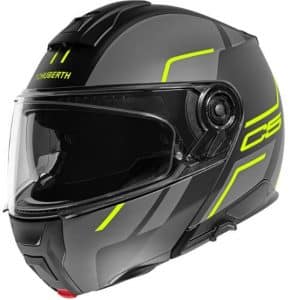
When discussing the new Schuberth C5, Jan Becker, the CEO of SCHUBERTH Helmets, emphasized,
“The Schuberth C5 marks the dawn of a new era in flip-up helmets. It’s the culmination of 20,000 engineering hours, encompassing rigorous testing of 2000 helmets in SCHUBERTH’s state-of-the-art environmental and wind test lab, and over 400 hours of real-world test rides on German roads.”
I wholeheartedly concur. Since 2019, I have regarded the C4 Pro, an upgrade from the 2017 C4, as the quietest model in the Schuberth brand. But, in 2022, the German manufacturer introduced a significant improvement in the Schuberth C5, resulting in an impressive noise level of 85 dB(A) at 62 mph (99.78 km/h) on a Sportster with no fairing, a feat achieved through an innovative neck roll concept that ensures a flawless seal at the bottom of the helmet shell and a well-sealed visor with insulated acoustic foam.
The Schuberth C5 surpasses the C4 and C4 Pro in every aspect (the additional $100 is well worth it). It’s even quieter than the 2023 Shoei Neotec 3, with the main difference between it and its predecessor Neotec II being the homologation (ECE 22.06 and ECE 22.05, respectively). I wear earplugs and sometimes listen to music; in my Neotec 3, the sound quality deteriorated at about 40 mph, but not with the C5.
To top it all off, the Schuberth C5 is the first helmet featuring the latest ECE 22.06 P/J homologation. An achievement that signifies that it not only meets but exceeds the stringent ECE chinbar test requirements, both with the chinbar open and closed, a fact clearly marked as ECE 22.06P/J.
Benefits:
- Outstanding aeroacoustics performance
- Stylish design
- Relatively quiet
Drawbacks:
- Pinlock overwhelmed on cold, wet rides
4. Arai Signet-X
This helmet is one of the quietest motorcycle helmets on the market, but it is more expensive.
The helmet does have a ventilation port that runs across the top of the helmet that will generate some level of noise if left open. New ventilation port running across the top of the helmet which if left open but with this helmet’s other noise-reducing design features, such as the chin curtain which is very effective at blocking noise, it’s definitely one of the quietest helmets available.
The fit of this helmet, however, does seem to be more suitable for people with a narrower / oval-shaped head.
Benefits:
- Great noise-blocking chin curtain
- Good air intake
- Wide field of view
Drawbacks:
- Top vents can pick upwind (and noise) that’s deflected by the visor
- The shell seems to be better fitted to people with a narrow/long oval head
5. HJC-RPHA-11 Pro
This helmet is slightly less expensive than the helmets listed above. But it is likely one of the quietest budget motorcycle helmets on the market. At average to lower speeds, this helmet offers great noise cancellation.
However, at higher speeds with a fairing, the helmet tends to pick up the wind being deflected and channel it through the helmet’s ventilation port which does increase the level of noise the rider experiences.
This helmet is categorized as a racing helmet so it’s also very lightweight and fits tightly. And, although most racing helmets do not come with ear packets, the HJC-RPHA-11-Pro does.
Overall, this helmet offers an average to good riding noise level when riding without a fairing.
Benefits:
- Great ventilation
- Very comfortable
- High-quality level
- Very lightweight
- Liner is moisture-wicking
- Comes in a variety of colors
- Eyeglass friendly
Drawbacks:
- Some vent noise at higher speeds
- Small ear pockets for speakers
- Sizing runs small (again, ensuring proper fit as discussed above is important for both the safety and effectiveness of noise reduction features)
6. Shark Evo One 2

The Shark Evo One 2 is another great modular visor flip-up option with the added benefit of being able to move the chin bar all the way to the back of the helmet. This allows the helmet to maintain a low center by keeping the chin bar away from the rushing wind when shifted to the backside of the helmet.
The helmet is sturdy and quiet. In fact, its shell design is specifically focused on not just aerodynamic design but noise cancellation. If you prefer the flexibility of riding with an open-face style helmet, the Evo One 2 might be the perfect choice for you as it offers this flexibility.
This helmet is also very lightweight. Although it may not be the quietest helmet compared to some others, it does offer a relatively quiet ride with additional bells and whistles such as the flexible chin bar and anti-scratch sun shield.
Benefits:
- Adaptable chin bar
- Premium anti-scratch shell design
- Very lightweight
- Removable/washable / anti-bacterial liner
Drawbacks:
- Some reviews indicate the chinstrap can be slightly uncomfortable
- Airflow from front to back is restricted
- Average noise reduction/cancellation
7. Sena Momentum INC Pro
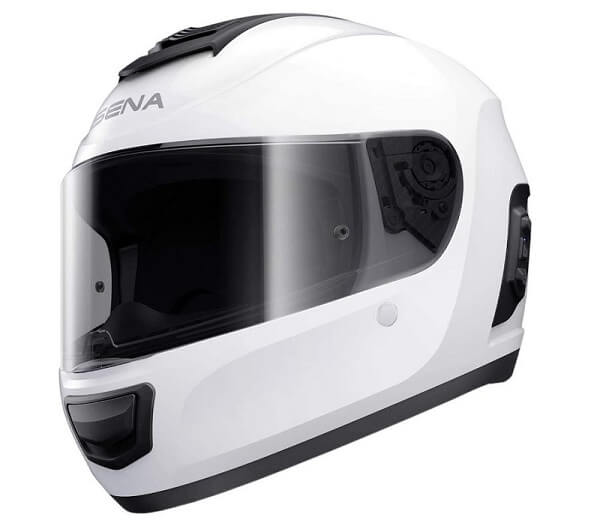
The Sena Momentum INC Pro is one of the quietest helmets available today, thanks to its Advanced Noise Control™ feature. It is also moderately lightweight. Sena officially lists its weight at 4.0125 pounds or 64.2 ounces (1,820 grams) for the medium size, but when I weighed it on a pelouze scale, it gave me a reading of 4.025 pounds or 64.41 ounces (1,826 grams), which is only a minor difference of 0.013 pounds or 0.21 ounces. These weights are within the averages based on long-term measurements.
You’ll love its narrower profile and aerodynamic design. The helmet features an intricate ventilation system with chin and forehead air intakes, as well as an exhaust port at the rear, allowing riders to stay cool.
Besides, the Sena Momentum INC Pro is integrated with Bluetooth 4.1, has built-in speakers and a microphone, an eight-way intercom, and is remote-controlled compatible. I haven’t come across many helmets with all these features.
Benefits:
- The face shield fits well and offers great noise cancellation
- The neck roll contributes to the helmet’s quietness
- Bluetooth-integrated
Drawbacks:
- Slightly heavier compared to alternative helmets
- May have limited compatibility with other brands or models of Bluetooth communication systems
- Limited color variety available, with only white being offered.
8. Bell Race Star Flex DLX
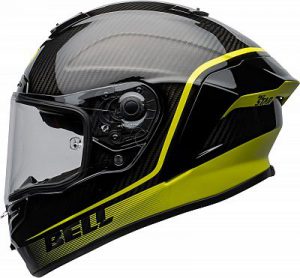
One clear benefit of this helmet is that it is very comfortable and weighs less than previous models. The helmet has been rigorously tested under harsh wind tunnel conditions and is extremely aerodynamic which contributes to the helmet’s noise-cancellation qualities.
Also contributing to the helmet’s noise-cancellation ability are the narrow neck roll and snug-fitting inner cheek pads which are very effective at reducing noise at high speeds. The helmet also offers a great field of view which improves the quality of the overall ride as well as improves safety.
A special feature of this helmet is the automatic transition visor which automatically balances the amount of light coming through the viewing port for the rider.
Benefits:
- Extremely comfortable fit
- Automatic transition visor
- Great field of view
Drawbacks:
- Takes some time to break in the inner padding
9. LS2 Challenger Helmet

This is a high-performance, full-face, sport-touring helmet made with a 100% carbon fiber shell for lighter weight. It has a retractable sun visor and offers great ventilation with fully adjustable vents. The shell is aerodynamic and lightweight and has fully adjustable vents that are ported through the liner to promote flow-through ventilation.
The helmet was designed for comfort during long rides with padding that is breathable without any hot spots. The face shield is scratch-resistant and has a retractable internal sun visor. The neck roll is designed to seal well and keep wind noise to a minimum.
Benefits:
- The helmet is very lightweight
- Very comfortable.
- Comes with a built-in shield that protects the rider from UV rays.
- The helmet’s shield is optically correct and has fog resistance too.
- The helmet has good ventilation with chin straps for a snug fit during racing or riding.
Drawbacks:
- The wide eye port of the helmet doesn’t automatically come with goggles (you have to buy them separately)
- Cheek pads fit on the tighter side.
- Minimal size selection (with fit being a primary concern for both safety and noise reduction)
You can watch more videos on our YouTube Channel:
Michael’s Summary and Conclusion
In the diverse landscape of motorcycle helmets available in the market, the examples mentioned above illustrate the wide array of options, each packed with unique features. If your quest is for a motorcycle helmet that guarantees minimal noise disturbance, a crucial aspect to consider is the proper fit of the helmet on your head.
Once you’ve narrowed down helmets that fit you perfectly, it’s essential to delve into the additional features associated with noise cancellation. Evaluate the helmet’s ability to create effective seals around openings like your neck, visor, and vents. Also, scrutinize the overall aerodynamics of the helmets before reaching a conclusion. These factors play a pivotal role in ensuring a tranquil riding experience.
But it’s crucial to acknowledge that there are several other variables at play, making it impossible to compile an exhaustive list within a single article. The very structure of your motorcycle, including instruments, mirrors, handlebars, bodywork, and windscreens, significantly influences the noise within the helmet. The information provided can guide you towards helmets that generally tend to be quieter, yet the ultimate noise reduction outcomes will be shaped by numerous real-life factors external to the helmet itself.
Moreover, altering certain elements, such as modifying your motorcycle’s components, can profoundly impact noise reduction. The insights shared in this article serve as a valuable compass, pointing you in the right direction to discover the quietest helmet tailored to your head shape and specific riding scenario.
By considering these factors thoughtfully, you can embark on your motorcycle journey with a helmet that ensures not only safety but also a peaceful and enjoyable ride.
Be sure to check out this in-depth article on the Pro Adventure Travel Pants, designed by motorcycle enthusiasts who share a deep passion for riding and adventure travel, especially on motorcycles.
Information for this article was partially sourced and researched from the following authoritative government, educational, corporate, and nonprofit organizations:
M/A


